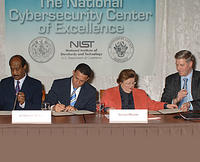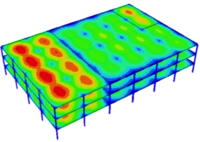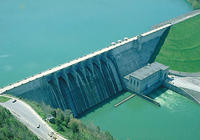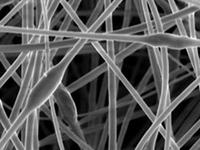-
Making storm warnings more exact, useful
The College of Staten Island (CSI)is the home of one of the most powerful mainframe computer systems in the country, an outgrowth of the City University of New York’s (CUNY) Decade of Science initiative. Following August 2011 Hurricane Irene, CSI scientistsset out to use that computing horsepower to generate scientific data hard enough to make the warnings something more than abstract. They fed millions of data points into the supercomputers, turning an admixture of geology, oceanography, climatology, and land surveys into a set of highly specific projections. Then, on 25 October 2012, Superstorm Sandy hit, and the actual water surges could be measured against the surge projections of the CSI model. On street after street, the computer model predicted flooding to within a foot of the actual surges.
-
-
Testing feasibility of deep geological storage of CO2 emissions
An injection of carbon dioxide, or CO2, has begun at a site in southeastern Washington to test deep geologic storage. Researchers are injecting 1,000 tons of CO2 one-half mile underground to see whether the greenhouse gas can be stored safely and permanently in ancient basalt flows. The United States and portions of Canada have enough potential capacity in geologic formations to store as much as 900 years of CO2 emissions.
-
-
SkySweeper robot inspects power lines easily, cheaply
Mechanical engineers invented a robot designed to scoot along utility lines, searching for damage and other problems that require repairs. Made of off-the-shelf electronics and plastic parts printed on an inexpensive 3D printer, the SkySweeper prototype could be scaled up for less than $1,000, making it significantly more economical than the two models of robots currently used to inspect power lines.
-
-
Next NIST workshop on critical infrastructure cybersecurity framework: Dallas, 11 September 2013

Registration is now open for the fourth in a series of workshops to bring together representatives from government, industry, and academia to establish a voluntary Cybersecurity Framework which will help reduce risks to critical infrastructure. The workshop will be held 11-13 September 2013, at the University of Texas at Dallas, and will be the final public session before the preliminary framework is formally released later this year.
-
-
Powering 1,000 homes would require using 32 acres for solar power plants
The Energy Department’s National Renewable Energy Laboratory (NREL) has published a report on the land use requirements of solar power plants based on actual land-use practices from existing solar facilities. Powering 1,000 homes would require setting aside 32 acres for solar power plants.
-
-
Man-induced quakes to help in building safer, sturdier buildings

A team led by Johns Hopkins structural engineers is shaking up a building in the name of science and safety. Using massive moving platforms and an array of sensors and cameras, the researchers are trying to find out how well a two-story building made of cold-formed steel can stand up to a lab-generated Southern California quake.
-
-
Ten-fold increase in frequency of Katrina-magnitude storms this century
Tropical cyclones arise over warm ocean surfaces with strong evaporation and warming of the air. Since 1923, there has been a Katrina magnitude storm surge every twenty years. Researchers found that 0.4 degrees Celcius warming of the climate corresponds to a doubling of the frequency of extreme storm surges like the one following Hurricane Katrina. If the temperature rises an additional degree, the frequency will increase by 3-4 times, and if the global climate becomes two degrees warmer, there will be about ten times as many extreme storm surges.
-
-
Water reservoirs for hydroelectric dams are sources of greenhouse gas emissions

The large reservoirs of water behind the world’s 50,000 large dams are a known source of methane. Like carbon dioxide, methane is one of the greenhouse gases which trap heat near Earth’s surface and contribute to global warming. Methane, however, has a warming effect twenty-five times more powerful than carbon dioxide. The methane comes from organic matter in the sediments that accumulate behind dams.
-
-
Dams play an important role in water pollution control

Small dams, reservoirs and ponds trap water pollution, which provides an important benefit to water resources. This is especially relevant in agricultural lands of the Midwest U.S., where there are lots of small, but aging, dams.
-
-
Mini-nuclear power plants may pull the nuclear industry out of a tight spot
Supporters of nuclear powers argue that mini-nuclear power plants offer the best hope for a struggling industry. These plants produce less energy, but they cost less, will be faster to build, and have less potential for a disaster.
-
-
Obama orders safety and security review of chemical plants
EPA data show there are 470 U.S. chemical facilities that put at least 100,000 people at risk in the event of a poison gas release. According to the American Chemistry Council, there are 13,796 chemical facilities in the country. The Fertilizer Institute counts about 6,000 fertilizer distributors around the country like the one that exploded 17 April. President Obama has ordered a government review of safety and security procedures at chemical plants in the United States.
-
-
Bacteria to clean contaminated leftover water used in fracking

Fracking is a drilling technique which uses lots of water — up to 5-7 million gallons per frack. One well may be fracked several times. The water goes in clean and comes out contaminated with organic substances that render it unfit for reuse. Purifying that water would reduce the pressure on waste disposal sites called injection wells, as well as on sites of wastewater spills. Researchers say that bacteria may someday clean leftover frack water.
-
-
Senate panel signs off on cybersecurity bill
The Senate Commerce Committee has approved a cybersecurity bill aiming to bolster protection of U.S. critical infrastructure. The full Senate will vote on the bill by the end of the year. The bill codifies parts of of President Obama’s February 2013 cybersecurity executive order. Among other things, the executive order instructs the National Institute of Standard and Technology (NIST) to draft a set of cybersecurity practices and standards.
-
-
Quake Summit 2013: showcasing research on earthquakes, tsunamis
Members of a national earthquake simulation research network next week will gather at the University of Nevada, Reno (UNR), for Quake Summit 2013, a scientific meeting highlighting research on mitigating the impact of devastating earthquakes and tsunamis. Titled “Earthquake & Multi-Hazards Resilience: Progress and Challenges,” the annual summit of the 14-site George E. Brown Network for Earthquake Engineering Simulation (NEES), will run from 6 August through 8 August at UNR’s Joseph Crowley Student Center.
-
-
Online tools accelerate progress in earthquake engineering, science
A new study has found that on-line tools, access to experimental data, and other services provided through “cyberinfrastructure” are helping to accelerate progress in earthquake engineering and science. The cyberinfrastructure includes a centrally maintained, Web-based science gateway called NEEShub, which houses experimental results and makes them available for reuse by researchers, practitioners, and educational communities. NEEShub contains more than 1.6 million project files stored in more than 398,000 project directories and has been shown to have at least 65,000 users over the past year.
-
More headlines
The long view
Helping Strengthen America’s Critical Infrastructure
Everyday life depends on a robust infrastructure network that provides access to running water, communications technology and electricity, among other basic necessities. The experts who keep our national infrastructure secure and resilient also need a strong network to share their knowledge and train the next generation of professionals capable of solving complex infrastructure challenges.
AI and the Future of the U.S. Electric Grid
Despite its age, the U.S. electric grid remains one of the great workhorses of modern life. Whether it can maintain that performance over the next few years may determine how well the U.S. competes in an AI-driven world.
Using Liquid Air for Grid-Scale Energy Storage
New research finds liquid air energy storage could be the lowest-cost option for ensuring a continuous power supply on a future grid dominated by carbon-free but intermittent sources of electricity.
Enhanced Geothermal Systems: A Promising Source of Round-the-Clock Energy
With its capacity to provide 24/7 power, many are warming up to the prospect of geothermal energy. Scientists are currently working to advance human-made reservoirs in Earth’s deep subsurface to stimulate the activity that exists within natural geothermal systems.
Experts Discuss Geothermal Potential
Geothermal energy harnesses the heat from within Earth—the term comes from the Greek words geo (earth) and therme (heat). It is an energy source that has the potential to power all our energy needs for billions of years.
